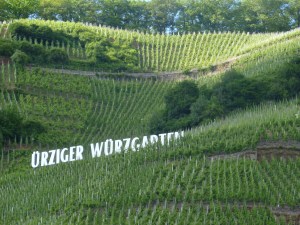
So much better than Hollywood
Some of my readers might remember our awesome tasting at Vereinigte Hospitien in June (if not, the venue is described here and the tasting notes are here). It should not be a surprise to you if I say that this tasting was not the last tasting of the day…we had an appointment with Stefan Erbes at Karl Erbes winery.
From Trier we headed to the autobahn to race to Ürzig (about 35 minutes down the Mosel, but our car was weighed down by the accumulated wine boxes in it, so we might have been a bit slower) because we had made arrangements with Stefan Erbes of Karl Erbes winery there. I first came across this winery, low and behold, through my friend ManSoo (yes, you have heard that name before). When friends of ours had given Nina a wine weekend along the Mosel as a birthday gift in 2011 we were looking at a lot of wineries. ManSoo suggested we give them a try, so we did. It was not a mistake. The tasting that day was epic: Stefan opened bottle after bottle, and we had tons of fun. We even came back the next morning for some of their sparkling wine (made like champagne, but cannot be called that for trademark reasons). We went back several times since, and Stefan has become a good friend.

View towards Erdener Prälat and Treppchen
For those unfamiliar with Ürzig let me quickly recap why I like that village so much. Ürzig is nestled to some steep hills along the Mosel. Just driving into it from the Autobahn gives you an idea how steep when the view opens up to the Mosel. This village is all about wine. The drive down the sloped roads also reveals vine after vine, even in the village. It is home or close to three of my favorite vineyards: Ürziger Würzgarten (Spice Garden), Erdener Treppchen (Little Steps), and Erdener Prälat (Prelate).
Karl Erbes winery is a rather young winery, founded in 1967. Karl Erbes had been cellarmaster for other wineries when he decided to start his own winery. Stefan, his son who is now in charge of wine making, joined in in 1984. The winery owns about 5 hectares (about 12.3 acres) in the Würzgarten and Treppchen, with ungrafted vines up to 80 years old. They recently were able to snatch a small lot in the much coveted Erdener Prälat (there is usually a scramble for lots there: only a handful of winemakers own or rent land in this tiny vineyard). I am really excited about this, because a) I love the Prälat wines and b) I love Stefan’s style of winemaking, so the combination should be great! The winery has a tasting room and wine bar where you can go and try their wines with some food during the summer months. It is a great way to spend an evening.
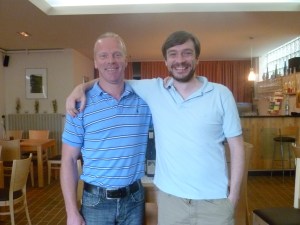
Stefan and I
Stefan is a great guy. I will never forget how open and welcoming he was when we first stumbled into their tasting room. There is nothing artificial about him: He is a straight talker, but he also has a wonderful sense of humor. He strongly cares about his wines, but there is also a human connection that I really enjoy. Last fall, I spent one day harvesting with his crew and the way he took care of me was really heart-warming. Silly me had not prepared a lunch package (hell, I was glad I made it out there at 7.30 AM!). So, he just brought me some of his mother’s home-cooked meal with a pastry bun and hot coffee for lunch. It was a great experience working in these vineyards, although I am glad I only did it for a day. My muscles were hurting the next few days…I later went with my mother, and we had a great time as well (Stefan’s uncle, who runs the wine bar, actually was able to convince my mother that riesling can be good…a feat I never accomplished). In short, it is one of the friendliest and most hospitable wineries I know.
Another cool thing is that Karl Erbes was smart enough to stash away bottles of each vintage and hold on to them. Their list of rarity wines is phenomenal (and so are the prices for these wines – for some 25+ year wines you pay as little as $15!). We have had incredible 1996 and 1997 wines, I tried a 1977 (my birthyear), and we have an 1987 put aside for another of Nina’s birthdays. It is a great chance to actually buy and try some old rieslings without paying a fortune.
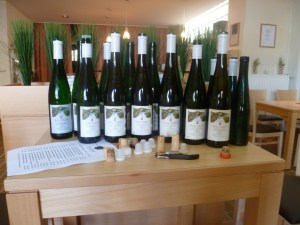
The line
Alright, with that, to the wines. We tried a total of 15 wines from Kabinett to Beerenauslese and ice wine, all 2011. If you are unaware of the wine levels in Germany, check out my at a glance sheet. As before, I will write about some wines seperately. All grapes are riesling grapes.
We started with two dry spätlesen from Würzgarten and Treppchen (he even produced a dry auslese, but we did not try that one). Again, it became clear that 2011 was a great year for dry rieslings. The 2011 Erdener Treppchen Spätlese trocken was mild with the typical Treppchen aromas of yellow fruit. The 2011 Ürziger Würzgarten Spätlese trocken was fuller bodied and had more muscle to it with its terroir typical floral notes. Both wines were quite good, but I do prefer the sweeter wines (as you should know by now).
On to the three semi-sweets: The Erdener Treppchen Spätlese halbtrocken was nicely silky on the tongue, with a good amount of acidity. But it was a bit too heavy for my taste. The Ürziger Würzgarten Kabinett feinherb was, again, floral but with distinct minerality to it and some not overpowering fruit. My star in this line up was the Ürziger Würzgarten Spätlese feinherb: full of minerality, awesome perfume notes in the nose, silky texture, long finish. Just a great, great typical Mosel wine.
On the sweet end of the spectrum, we tried ten wines. This is where Stefan is really strong. The Ürziger Würzgarten Kabinett was an explosion of fruit, with some banana, and the sweetness wrapped in healthy acidity. The spätlesen and his auslesen will be dealt with in a seperate post.
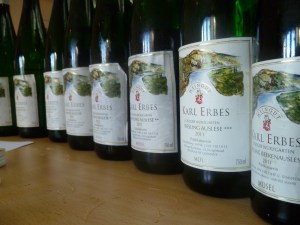
We finished with the Beerenauslese (BA) from Treppchen and Würzgarten. The Treppchen had so much fruit in it that it was hard to wrap your head around. The viscosity on the tongue, the sugar and acidity playing on your tongue, the seemingly endless finish made this wine incredibly sensuous. At 301 grams of residual sugar per liter, you would think it is all syrup, but it was not. The Würzgarten, with an insane 315 grams of residual sugar per liter, was much more lively than the Treppchen. The wine was dancing on my tongue with tons of dried fruits. These wines are not for daily consumption, and they are not ready for consumption at this point. But they will be stellar in many years to come…
But we were not quite finished yet. Stefan was pouring us a browny, slightly milky wine without telling us what it was and asked us what we thought of it. The wine tasted somewhat off, it had a somewhat muggy smell. It had some salty notes in it, too. Turned out it was berries he harvested as ice wine on February 3, 2012. That is pretty far into the new year, even for an ice wine. The problem was that some berries were rotten at that point. So, he cannot sell it as an ice wine (grapes have to be healthy), but it was still an interesting experience…
We had big plans to go back once more after an insane 24 hour Rome trip the next week, but it turned out that a night without sleep was not the best starting point for going to theirs the next morning. So we had to skip that. But I am really looking forward to the next visit!! Stefan speaks good English, so please go and visit them if you get the chance. Readers in Europe can order their wines through their website at winery prices plus a modest shipping fee. There is absolutely no reason not to try their wines.
With that, we ended our trip to the Mosel in June 2012. I so cannot wait to go back.
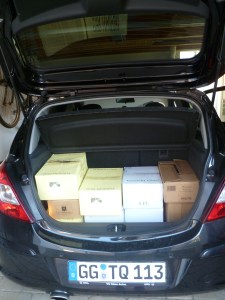
Back in my hometown









